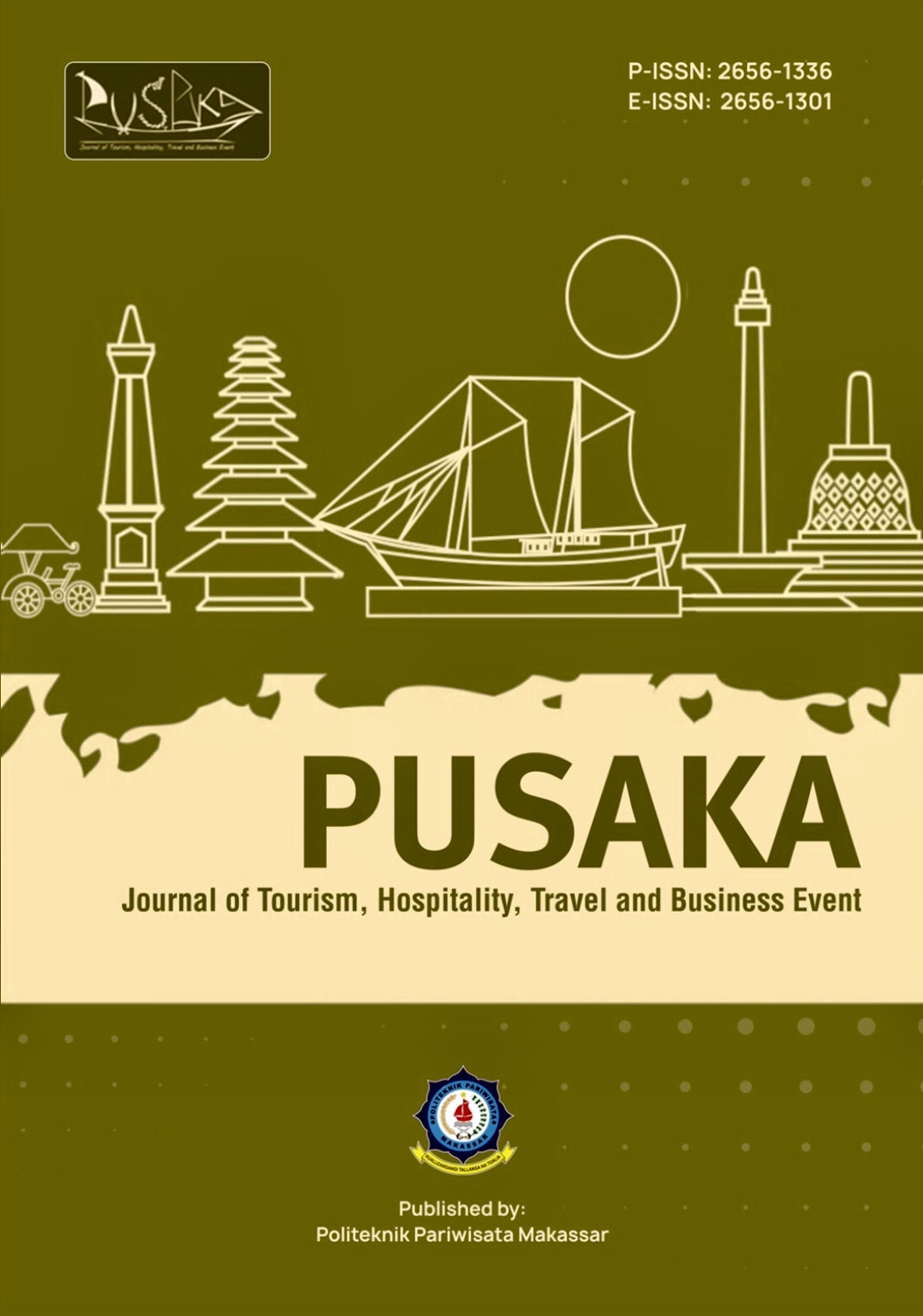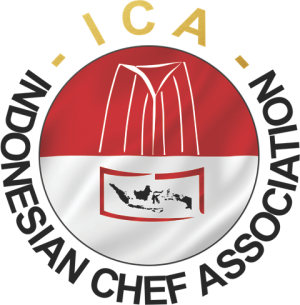Feasibility Study of Homestay Management in Rural Villages (Tebat Meringang Lame, South Sumatra)
DOI:
https://doi.org/10.33649/pusaka.v6i1.97Keywords:
Feasibility, Human Resources, Tourism, Homestay, Ghumah BaghiAbstract
This research aims to identify the current management conditions and assess the feasibility of developing homestays in Tebat Lereh Meringang Lame tourist village, South Sumatra. The research methodology involved interviews and observations with informants, including homestay managers and administrators of tourism awareness groups. The study revealed that only one person can manage each homestay in the tourist village. The same person may have multiple roles, such as receptionist, room attendant, and kitchen manager. The feasibility of developing homestays in the village depends on physical environmental conditions, such as landscape characteristics, cool air, and an authentic rural atmosphere, as well as the uniqueness of Ghumah Baghi architecture and the hospitality of Basemah Malay culture. It is recommended that the number of personnel in each homestay be increased according to workload standards. The required skills for this position include reception and room attendance, food management, and improving local literacy about Ghumah Baghi
References
Adamov, T., Iancu, T., Peț, E., Popescu, G., Șmuleac, L., Feher, A., & Ciolac, R. (2023). Rural Tourism in Marginimea Sibiului Area—A Possibility of Capitalizing on Local Resources. Sustainability (Switzerland), 15(1). https://doi.org/10.3390/su15010241
Arios, R. L. (2014). Permukiman Tradisional Orang Basemah di Kota Pagaralam [Traditional settlement of Besemah in Kota Pagaralam]. Jurnal Jnana Budaya, 19(2).
Ayuningtyas, P. (2021). Pelatihan “English for Guiding” Bagi Pemandu Wisata Lokal Kabupaten Puworejo. Jurnal Abdimas Bina Bangsa, 02(01).
Baswarani, D. T. (2021). Sumber Daya Manusia Berkualitas untuk Pariwisata Berkualitas. Warta Pariwisata, 19(2). https://doi.org/10.5614/wpar.2021.19.2.04
Bhangu, S., Provost, F., & Caduff, C. (2023). Introduction to qualitative research methods - Part i. Perspectives in Clinical Research, 14(1). https://doi.org/10.4103/picr.picr_253_22
Bhattacharya, P., Mukhopadhyay, A., Haldar, S., Saha, J., Mondal, M., Samanta, B., Bhattacharya, S., & Paul, S. (2023). Commercialisation of Home Through Homestay Tourism: A Study on Chatakpur of Darjeeling District (India) in Commensurate to ASEAN Standard and Revisit Intention. Global Social Welfare. https://doi.org/10.1007/s40609-023-00305-7
Budhi Pamungkas Gautama, Yuliawati, A. K., Nurhayati, N. S., Fitriyani, E., & Pratiwi, I. I. (2020). PENGEMBANGAN DESA WISATA MELALUI PENDEKATAN PEMBERDAYAAN MASYARAKAT. BERNAS: Jurnal Pengabdian Kepada Masyarakat, 1(4). https://doi.org/10.31949/jb.v1i4.414
Bury, J. (2020). Introducing storytelling into tourism and hospitality courses: students’ perceptions. Journal of Teaching in Travel and Tourism, 20(2). https://doi.org/10.1080/15313220.2019.1665486
Chaerunissa, S. F. (2020). Analisa Pengembangan Komponen Pariwisata Desa Wisata Wonolopo Kota Semarang. Ejournal-Undip, III(1).
Chen, X., & Tao, X. (2023). Rural Tourism Model Based on Two Different Resource Endowments: Green + Health Tourism Model in Jiulong Community and Cultural Tourism Model in Moyuan Village. Journal of Environmental and Agricultural Studies, 4(1). https://doi.org/10.32996/jeas.2023.4.1
Dash, S. P. (2022). Exploring the Prospects of Homestays in Indian Tourism and Hospitality Industry as an Alternate Preference for Stay. International Journal of Built Environment and Sustainability. https://doi.org/10.11113/ijbes.v9.n3.935
Firman Koma Febdilan. (2022). THE HOTEL DEPARTMENT STANDARDIZATION TO IMPROVE STUDENT COMPETENCE IN THE HOUSEKEEPING AND FRONT OFFICE DEPARTMENT THROUGH FIELD INDUSTRIAL PRACTICES IN MATARAM CITY AND WEST LOMBOK. International Journal of Social Science, 1(5). https://doi.org/10.53625/ijss.v1i5.1313
Greer, T., & Wagner, J. (2023). The interactional ecology of homestay experiences: Locating input within participation and membership. Second Language Research, 39(1). https://doi.org/10.1177/02676583211058831
Humas Kemenparekraf. (2022). ADWI 2022, Menparekraf: 50 Desa Wisata Terbaik Simbol Kebangkitan Ekonomi Indonesia. Sekretariat Kabinet Republik Indonesia.
Ibnu, I. M., Siswanto, A., Prihatmaji, Y. P., & Nugroho, S. (2023). Typology of wood joint geometry in Basemah highland vernacular architecture, south Sumatra, Indonesia. Journal of Design and Built Environment, 23(1). https://doi.org/10.22452/jdbe.vol23no1.1
Jiang, G. X., Li, Y. Q., Zhang, S. N., & Ruan, W. Q. (2022). How to impress guests: Key factors and strategy configurations for the accommodation memories of homestay guests. Journal of Hospitality and Tourism Management, p. 50. https://doi.org/10.1016/j.jhtm.2022.02.017
Jo, M., Cha, J., & Kim, J. (2022). The Effects of Tourism Storytelling on Tourism Destination Brand Value, Lovemarks and Relationship Strength in South Korea. Sustainability (Switzerland), 14(24). https://doi.org/10.3390/su142416495
KC, B. (2021). Ecotourism for wildlife conservation and sustainable livelihood via community-based homestay: a formula to success or a quagmire? Current Issues in Tourism, 24(9). https://doi.org/10.1080/13683500.2020.1772206
KEMENPAN. (2004). Pedoman Perhitungan Kebutuhan Pegawai Berdasarkan Beban Kerja Dalam Rangka Penyusunan Formasi Pegawai Negeri Sipil. In Kep.Men.PAN Nomor: KEP/75/M.PAN/7/2004.
KEMENTERIAN PARIWISATA DAN EKONOMI KREATIF / BADAN PARIWISATA DAN EKONOMI KREATIF. (2024). Desa Wisata Tebat Lereh Meringang. Https://Jadesta.Kemenparekraf.Go.Id/Home.
Kim, S. H., Song, M. K., & Shim, C. (2020). Storytelling by medical tourism agents and its effect on trust and behavioural intention. Journal of Travel and Tourism Marketing, 37(6). https://doi.org/10.1080/10548408.2020.1795046
Köhler, T., Smith, A., & Bhakoo, V. (2022). Templates in Qualitative Research Methods: Origins, Limitations, and New Directions. Organisational Research Methods, 25(2). https://doi.org/10.1177/10944281211060710
Kontogeorgopoulos, N., Churyen, A., & Duangsaeng, V. (2015). Homestay Tourism and the Commercialization of the Rural Home in Thailand. Asia Pacific Journal of Tourism Research, 20(1). https://doi.org/10.1080/10941665.2013.852119
Kualaria, S., Wijayantini, B., & Hanafi, I. (2022). Peran Masyarakat Lokal Dalam Pengembangan Potensi Desa Wisata. National Multidisciplinary Sciences, 1(1). https://doi.org/10.32528/nms.v1i1.5
Levyda, L., Giyatmi, G., & Paranita, E. S. (2019). HOMESTAY BUSINESS STANDARDS TRAINING FOR HOMESTAY OWNER ON HARAPAN ISLAND. ICCD, 2(1). https://doi.org/10.33068/iccd.vol2.iss1.264
Lexy J, M. (2019). Metodologi Penelitian Kualitatif. Bandung, Remaja Rosdakarya.
Lexy J. Moleong, Dr. M. A. (2019). Metodologi Penelitian Kualitatif (Edisi Revisi). PT. Remaja Rosda Karya. https://doi.org/10.1016/j.carbpol.2013.02.055
Li, W., Zhou, Y., Dai, X., & Hu, F. (2022). Evaluation of Rural Tourism Landscape Resources in Terms of Carbon Neutrality and Rural Revitalization. Sustainability (Switzerland), 14(5). https://doi.org/10.3390/su14052863
Lyimo, B., & Joachim, A. (2022). Job Stress Towards Employee Performance of the Banking Sector. Researchgate.Net, 4(1).
Maya Fitri Oktarini, H. M. H. dan J. A. (2022). Konservasi Baghi Sebagai Objek Wisata Dari Desa Perapau, Semendo Darat Laut, Sumatera Selatan. Jurnal Pengabdian, 4.
McDonnell, B. (2008). A conservative vowel phoneme inventory of Sumatra: The case of baseman. Oceanic Linguistics, 47(2). https://doi.org/10.1353/ol.0.0020
McDonnell, B. (2016). Acoustic correlates of prominence in Besemah (Malayic, Indonesia). Journal of the Acoustical Society of America, 140(4_Supplement). https://doi.org/10.1121/1.4970886
Murniati, D. E., Razzaq, A. R. B. A., Ismail, A. Bin, & Mota, L. (2023). Training Urgency to Bridge the Digital Divide for Social Media Marketing Awareness and Adoption: Case of CBT Rural Homestay Operators Malaysia. Journal of Technical Education and Training, 15(1). https://doi.org/10.30880/jtet.2023.15.01.013
Onsardi. (2020). Manajemen Sumber Daya Manusia. Modul Kuliah MSDM International.
Pajriah, S. (2018). PERAN SUMBER DAYA MANUSIA DALAM PENGEMBANGAN PARIWISATA BUDAYA DI KABUPATEN CIAMIS. Jurnal Artefak, 5(1). https://doi.org/10.25157/ja.v5i1.1913
Prastowo, I. (2022). Housekeeping Development For Homestay Managers In Kampung Purba Tourism Village, Dayu, Gondangrejo Karanganyar. JURNAL PENGABDIAN TEKNOLOGI TEPAT GUNA, 3(2). https://doi.org/10.47942/jpttg.v3i2.1015
Rahayu, E. (2023). What Makes Tourists Stay in Homestay? The Correlation Between Service and Occupancy at Homestay Around Borobudur SuperPriority Destination. International Journal of Tourism and Hospitality in Asia Pacific, 6(1). https://doi.org/10.32535/ijthap.v6i1.2105
Rayyan Aqila Praditya. (2022). Kinerja Organisasi Pada Manajemen Rantai Pasokan Pariwisata : Bagaimana Peran Manajemen Sumber Daya Manusia , Kepuasan Pelanggan ? International Journal of Social, Policy, and Law (Ijospl), 03(02).
Riadhussyah, M. (2020). Pengembangan Sumber Daya Manusia di Bidang Wisata Halal dalam Menghadapi Revolusi Industri 4.0. Jurnal MSDA (Manajemen Sumber Daya Aparatur), 8(1). https://doi.org/10.33701/jmsda.v8i1.1164
Semwal, R., & Singh, A. (2023). HARNESSING HOMESTAYS: A PROMISING APPROACH TO SAFEGUARDING CULTURAL HERITAGE. In Peer Reviewed and Refereed Journal (Issue 6).
Setiawan, I. R. (2016). Pengembangan Sumber Daya Manusia di Bidang Pariwisata: Perspektif Potensi Wisata Daerah Berkembang. Jurnal Penelitian Manajemen Terapan, 1(1).
Syamsuddin, S., Suraya, S., & Haeril, H. (2023). MANAJEMEN SUMBER DAYA MANUSIA PADA DINAS PARIWISATA, PEMUDA DAN OLAHRAGA KOTA BIMA. Jurnal Komunikasi Dan Kebudayaan, 10(1). https://doi.org/10.59050/jkk.v10i1.224
Thanvisitthpon, N. (2021). Statistically validated component and indicator-level requirements for sustainable Thai homestay businesses. Sustainability (Switzerland), 13(2). https://doi.org/10.3390/su13020936
Wang, Y. (2007). Customised authenticity begins at home. Annals of Tourism Research, 34(3). https://doi.org/10.1016/j.annals.2007.03.008
Wibowo, S., Muchlis, N. F. F., & Yahya, M. (2023). Local Culinary Travel Pattern Development Model in Lerep Tourism Village. Pusaka: Journal of Tourism, Hospitality, Travel, and Business Events, 5(1). https://doi.org/10.33649/pusaka.v5i1.192
Wijaksono, P., Martono, & Suprianto, A. P. (2020). Cultural Study: Ghumah Baghi Philosophy of Besemah Ethnic Society. https://doi.org/10.2991/assehr.k.201201.112
Yulianah, Y. (2021). MENGEMBANGKAN SUMBER DAYA MANUSIA UNTUK PARIWISATA BERBASIS KOMUNITAS DI PEDESAAN. Komitmen: Jurnal Ilmiah Manajemen, 2(1). https://doi.org/10.15575/jim.v2i1.12472
Zhang, J., Xiong, K., Liu, Z., & He, L. (2022). Research progress and knowledge system of world heritage tourism: a bibliometric analysis. In Heritage Science (Vol. 10, Issue 1). Springer Science and Business Media Deutschland GmbH. https://doi.org/10.1186/s40494-022-00654-0
Zhao, F., Jiang, M., Zhang, J., & Nie, R. (2019). Research on the rural homestay in development under rural revitalisation: A case of “Ten Thousand Hostels” in Zengcheng District, Guangzhou City. Chinese Journal of Eco-Agriculture, 27(2). https://doi.org/10.13930/j.cnki.cjea.180593
Downloads
Published
How to Cite
Issue
Section
License

This work is licensed under a Creative Commons Attribution-ShareAlike 4.0 International License.






















